All About UNOS
By Joan Tupponce
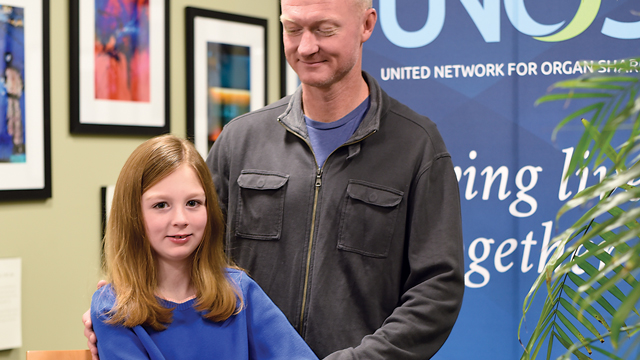
Charlotte Cavanagh’s parents were thrilled when their daughter was born. She was the couple’s first child, and everything about the delivery and their new baby seemed typical. But just two days after her parents brought Charlotte home, she wouldn’t eat and became lethargic.
“My mother-in-law, who had been a nurse for more than thirty years, was visiting. She was picking up on things faster than we were,” says Charlotte’s dad, Chris.
Frantic, the couple took their newborn to the emergency room in the middle of the night. The hospital ran a battery of tests over the next few days. The hospital expedited the test results and doctors diagnosed baby Charlotte with a metabolic disorder called propionic acidemia. “The cells in her body don’t break down protein like cells in our bodies,” Cavanagh says. “When she ingests protein, her cells produce propionic acid and her blood becomes toxic. It can quickly spiral out of control.”
When Charlotte doesn’t eat, her body begins to break down muscle and fat. In response, her cells produce more acid. “It’s a vicious cycle,” Cavanagh says. “The only way to manage it is through special formulas stripped of key amino acids.”
The couple did a great deal of research on Charlotte’s medical issue and learned that the life expectancy for someone with the disorder was approximately fourteen years. “She could have a lot of complications,” Cavanagh says. “That’s a tough existence for a kid.”

The family was in the emergency room multiple times for the first two and a half months of Charlotte’s life. “We couldn’t stay on top of these cycles where she would spiral out of control and be in metabolic crises,” Cavanagh says.
The family moved from Raleigh to Richmond when Charlotte turned two and began working with a doctor who was a nationally recognized expert in the field of metabolic disorders at Children’s National Hospital in Washington, D.C. “We had a conversation about trials and successful results,” Cavanagh says. “We got to this point where Charlotte was having a hard time, and we had to make a decision whether or not to pursue a liver transplant with the blessing of the metabolic doctor.”
The family decided to work with Georgetown University Hospital, which is well-regarded for pediatric outcomes. After she was placed on the organ donor transplant list, Charlotte ranked high on the pediatric list because of the severity and progression of the disease, along with other factors. “We expected something to happen in weeks or months, tops.”
The Cavanaghs weren’t aware that behind the scenes, a Richmond-based organization had been activated to find a life-saving organ match for their young daughter. The United Network for Organ Sharing (UNOS) helps the community of donation and transplant professionals make the best possible use of organs to save lives. UNOS (pronounced you-nos) has played a vital role in the evolution of the transplantation field in the United States during the past thirty years.
Six months had gone by when the Cavanaghs received a call that Charlotte had been designated as a backup candidate for a liver, which ultimately went to the first recipient on the list. A week later, the couple made the decision to decline an organ from an adult donor because a pediatric donor was ideal in Charlotte’s case.
Shortly thereafter, they got the word there was a perfect match for Charlotte. “This was a tragedy for some other family who had to go through the worst day of their lives,” says Cavanagh.
Everything fell into place for the transplant. Two-year-old Charlotte had no complications and no rejection issues. When the couple left the hospital, their daughter “was a different child than when we went in,” her dad says. “She was non-verbal when we went in and after the transplant, she sang Twinkle Twinkle Little Star. We didn’t even know she knew the words.”
Now almost ten, Charlotte is a healthy liver transplant recipient. “She will have to take anti-rejection drugs all of her life. She still has an underlying issue, but a much better outcome,” says Cavanagh. “Her prognosis is great. We worried about our child not outliving us, but now things are the way they are supposed to be.”
The family became aware of UNOS and the important work the organization does only after the fact. “We have done everything we can to champion the important work they do,” Cavanagh says. “It’s a great organization.”
Becoming UNOS
A nonprofit, scientific, and educational organization, UNOS was founded in 1984, the same year Congress passed the National Organ Transplant Act that established a national network called the Organ Procurement and Transplantation Network. The OPTN coordinates the allocation of organs and collects clinical data about organ donors, transplant candidates, and transplant recipients.
Headquartered in Richmond at VA Bio+Tech Park on Fourth Street, UNOS is a private, nonprofit organization that serves as the nation’s only OPTN under contract with the Health Resources and Services Administration of the U.S. Department of Health and Human Services. Since 1984, the organization has grown from a handful of employees to more than 380 full-time staff members who work in Richmond. The UNOS teams works closely with the fifty-eight organ procurement organizations nationwide designated by the Centers for Medicare and Medicaid and more than 250 transplant centers across the nation.

Today, there are approximately one hundred life-saving organ transplants performed in the United States every day. There are currently more than 113,000 people waiting for an organ transplant. Most of them – nearly 95,000 – need a kidney. Another almost 13,000 are waiting for a liver.
“The most common organ transplanted is the kidney. That is where the greatest need is,” says Marlon Levy, MD, chair of the division of transplant surgery and director of the VCU Health Hume-Lee Transplant Center. “Every transplant center works with UNOS. It plays a critical role in America for transplant recipients and patients on the waitlist. [UNOS] makes sure the system moves appropriately and as many organs can be transplanted as possible.”
A Hub of Activity
The F.M. Kirby Foundation Organ Center at UNOS is open around the clock, seven days a week and 365 days a year to deal with organ procurement agencies and compatibility labs that support hospitals and transplant centers. Its approximately 20-member staff works 12-hour shifts to save lives by matching donors with candidates on the transplant waiting list.
Located in the middle of the UNOS building, the Organ Center resembles what you might think of when you envision a mission control-style command center. Clocks with all time zones line the walls. A large custom map shows different UNOS regions across the country. The map also designates cities with airports that UNOS uses so organs can be transported for life-saving surgeries.
“We deal with hundreds of calls a day,” says the center’s director, Roger Brown. “We have a board that shows the number of calls. In the center, you do a lot of teamwork and technology troubleshooting.”
Brown joined the Organ Center as an organ placement specialist in 1995. He became assistant director in 2009 and director in 2015. One of the reasons he wanted to work at UNOS was because when he was in college, his father had a heart transplant.
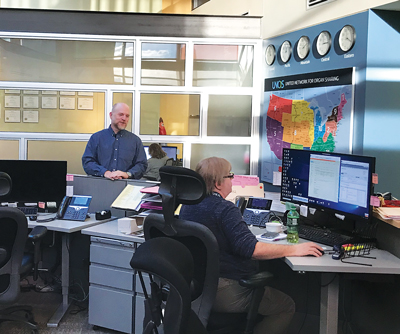
The primary functions of the Organ Center are to: assist in placing donated organs for transplantation; assist in gathering donor information and running the donor-to-recipient computer matching process; assist with transportation of organs and tissues for the purposes of transplantation; and act as a resource to the transplant community regarding organ-sharing policies.
UNOS works with a number of transportation providers throughout the country to facilitate door-to-door transportation anywhere in the U.S. The center can help arrange ground transportation or charter aircraft, if need be. “It’s usually a combination of drive and fly most
of the time,” Brown says. “Most of the kidneys that travel any distance would be transported via commercial airlines. It works pretty well.”
The organization averages twenty-four to thirty organs every day. “We have the capability, capacity, and education to allocate any organ,” says Brown.
Factors that can make an organ hard to place for transplantation include the age of the donor, a donor history of diabetes or some other disease, as well as anatomical anomalies of an organ, such as a kidney with multiple blood vessels.
According to Brown, most organs are primarily allocated to recipients who live near the donor. LifeNet Health, an organ procurement organization in Richmond, handles most of the organs donated in Virginia. “We do not get involved with placing organs in the area,” Brown says.
Heart, lung, and liver organs typically stay in the regions in which they are donated. Thanks to the gift of life from organ donors and their families, the number of donors and transplants performed in the United States are at all-time highs. In 2018, there were 21,167 kidney transplants performed. “Kidneys can be shared more broadly across the country,” Brown says.
Making the Match
The entire national waiting list for organs is housed in the UNOS database. “We know all the clinical information, what organ they need, etc.,” Brown says. “When a donor organ becomes available, the clinical and demographic information is entered in and that is where matches take place.”
Patients whose size or blood type may be incompatible with the donor are eliminated, creating a ranked list of patients who are compatible. Those patients are then ranked according to allocation policies that are developed and approved by the organization’s transplant community that serves on its committees and board of directors.
George Mazariegos, MD, director of pediatric transplantation at UPMC Children’s Hospital of Pittsburgh works with transplants that are matched and coordinated through UNOS.
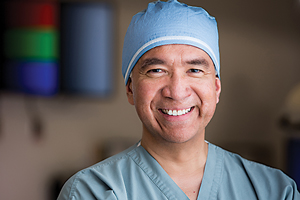
UNOS gives the committee the opportunity to help shape policy with the understanding that there are legal language and congressional mandates that have to be met. “It’s a privilege to work at UNOS as a volunteer,” Dr. Mazariegos says.
Factors, including medical urgency, location, waiting time, and proximity of transplant hospital to donor hospital are taken into consideration with all organ placements. Pediatric patients get priority for pediatric organs, and priority is also given to people who have served as living donors.
“There can be a misconception that staff in the building are determining where an organ goes,” Brown says about the systematic UNOS process. “We are using that ranked order, and we electronically notify staff at transplant hospitals that an organ is available. They ping us back whether they do or don’t have interest.”
Dr. Levy and his team at VCU Health receive notice electronically and from there, a decision is made about the suitability of the organ. “In the case of a heart, liver, or lung transplant, a team has to be dispatched to the hospital where the organ will be procured. Everything has to happen with exact timing,” he says. “Kidneys can travel longer distances and stay out of the body longer.” Dr. Levy adds that kidneys can be transported on commercial airlines.
The organ is transplanted into the patient soon after it is received; that’s where the hospital team is key. “We make sure the recipient is admitted to the hospital and prepared for the operation when we know it’s a match,” Dr. Levy says. “In 2019, we are on track to do 430 organ transplants [at VCU Health]. That puts us in the top tier of transplant centers by volume.”
UNOS Team Member is Living Proof
Born in 1980 in Northern Virginia, Kim Uccellini seemed perfectly normal to her family. There were no issues at birth. In toddlerhood, however, her pediatrician noted Kim was pale, fatigued, and anemic. Later, tests revealed her right kidney never fully formed, and her left kidney was only partially functioning.
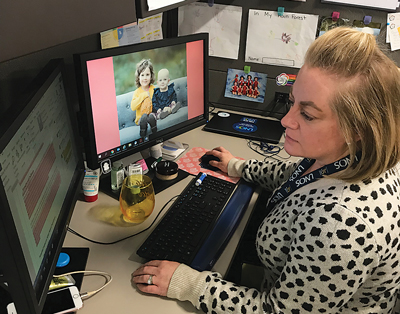
When her lone kidney’s function continued to decline, she was listed for a transplant. She and her family waited for about two years. “I was called in three times. The first two calls didn’t pan out, but three’s a charm,” she says. “I was transplanted August 7, 1989. Post-transplant, I was a different person. My color returned, and I had energy. I took interest in dance and sports. Formerly reserved and shy, I became more outgoing and confident.”
Now, thirty years later, she leads a very normal life that wouldn’t have been possible had she not received a transplant. “I discovered a passion for the sport of rowing, graduated from college, earned two graduate degrees, traveled, got married, and had two kids,” she says.
As a transplant recipient, working at UNOS is special to her. “UNOS really does feel like extended family,” she says. “I have colleagues here who have spent their entire career working here and were working here when I was transplanted. People here are passionate about what they do and that feels great.”
Building Community in Richmond
Each year, hundreds of visitors, both donor families and transplant recipients, visit the National Donor Memorial at the UNOS headquarters to honor organ, eye, and tissue donors from across the country. “It’s a memorial designed for family members and friends of deceased organ donors to remember and honor their loved ones,” says Lisa Schaffner, the organization’s director of public relations and marketing, noting the Memorial was dedicated in 2003, the same year it moved into its headquarters in the City of Richmond. “It’s also a place where transplant recipients and their families can visit to honor those who’ve given the gift of life.”
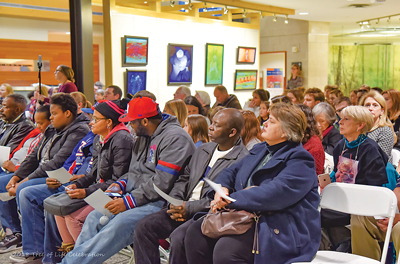
Visitors often leave remembrances honoring donors in the small niches on The Wall of Names. “Among some of the items that have been left over the last few months include a teddy bear, flowers, and notes,” says Schaffner, whose favorite spot at the Memorial is The Grove. “Each drop of water that hits the pool symbolizes a donor who gives the gift of life and how that donation touches and transforms so many lives, symbolized by the rippling of the fountain’s water.”
The National Donor Memorial is open seven days a week to visitors for self-guided tours with informational brochures available onsite. People can also visit the memorial anytime via a virtual tour at UNOS.org.
Another community gathering place is The Gallery at UNOS, which debuted in September 2010 with an exhibition called, Thirty Years of Giving Back: A Retrospective by Dr. W. Baxter Perkinson, Jr. “It was the first time that art from all thirty years of Baxter’s painting career had been displayed in one space,” says Schaffner, noting the gallery is open to the public Monday through Friday from 8 a.m. to 5 p.m.

Original works of art are exhibited in six separate shows throughout the year and are on display for periods of two months.
“It is the organization’s hope that people coming to the gallery will not only be inspired by the art, but also by the UNOS mission of saving lives across the country through organ transplantation,” says Schaffner.
photos: Courtesy UNOS, Sherri Williams, Scott Schwartzkopf
